Multi-subject dictionary learning & CanICA¶
Reference:
This example applies dictionary learning and ICA to resting-state data, visualizing resulting components using atlas plotting tools.
Dictionary learning is a sparsity based decomposition method for extracting spatial maps. It extracts maps that are naturally sparse and usually cleaner than ICA. CanICA is an ICA method for group-level analysis of fMRI data. Compared to other strategies, it brings a well-controlled group model, as well as a thresholding algorithm controlling for specificity and sensitivity with an explicit model of the signal.
Varoquaux et al. “A group model for stable multi-subject ICA on fMRI datasets”, NeuroImage Vol 51 (2010), p. 288-299
Varoquaux et al. “ICA-based sparse features recovery from fMRI datasets”, IEEE ISBI 2010, p. 1177
Gael Varoquaux et al. Multi-subject dictionary learning to segment an atlas of brain spontaneous activity Information Processing in Medical Imaging, 2011, pp. 562-573, Lecture Notes in Computer Science
[1]:
%matplotlib inline
%load_ext autoreload
%autoreload 2
import os, sys
import numpy as np
import nibabel as nib
from skimage import io
import matplotlib.pylab as plt
sys.path += [os.path.abspath('.'), os.path.abspath('..')] # Add path to root
import notebooks.notebook_utils as uts
/mnt/datagrid/personal/borovec/Applications/vEnv2/lib/python2.7/site-packages/h5py/__init__.py:36: FutureWarning: Conversion of the second argument of issubdtype from `float` to `np.floating` is deprecated. In future, it will be treated as `np.float64 == np.dtype(float).type`.
from ._conv import register_converters as _register_converters
/mnt/datagrid/personal/borovec/Applications/vEnv2/lib/python2.7/site-packages/IPython/html.py:14: ShimWarning: The `IPython.html` package has been deprecated. You should import from `notebook` instead. `IPython.html.widgets` has moved to `ipywidgets`.
"`IPython.html.widgets` has moved to `ipywidgets`.", ShimWarning)
load datset¶
[2]:
# uts.DEFAULT_PATH = '/datagrid/Medical/microscopy/drosophila/synthetic_data/atomicPatternDictionary_v0'
p_dataset = os.path.join(uts.DEFAULT_PATH, uts.SYNTH_DATASETS_FUZZY[0])
print ('loading dataset: ({}) exists -> {}'.format(os.path.exists(p_dataset), p_dataset))
p_atlas = os.path.join(uts.DEFAULT_PATH, 'dictionary/atlas.png')
atlas_gt = io.imread(p_atlas)
nb_patterns = len(np.unique(atlas_gt))
print ('loading ({}) <- {}'.format(os.path.exists(p_atlas), p_atlas))
plt.imshow(atlas_gt, interpolation='nearest')
_ = plt.title('Atlas; unique %i' % nb_patterns)
loading dataset: (True) exists -> /datagrid/Medical/microscopy/drosophila/synthetic_data/atomicPatternDictionary_v0/datasetFuzzy_raw
loading (True) <- /datagrid/Medical/microscopy/drosophila/synthetic_data/atomicPatternDictionary_v0/dictionary/atlas.png
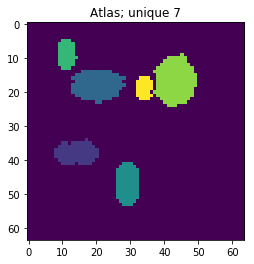
[3]:
list_imgs = uts.load_dataset(p_dataset)
print ('loaded # images: ', len(list_imgs))
img_shape = list_imgs[0].shape
print ('image shape:', img_shape)
nii_images = [nib.Nifti1Image(np.expand_dims(img, axis=0), affine=np.eye(4)) for img in list_imgs]
mask_full = nib.Nifti1Image(np.expand_dims(np.ones(atlas_gt.shape, dtype=np.int8), axis=0), affine=np.eye(4))
('loaded # images: ', 800)
('image shape:', (64, 64))
[17]:
from nilearn.input_data import NiftiMasker
masker = NiftiMasker(low_pass=0.5, verbose=0)
masker.fit(nii_images)
print ('shape:', masker.mask_img_.get_data().shape)
print ('values:', np.unique(masker.mask_img_.get_data()))
_= plt.imshow(masker.mask_img_.get_data()[0])
('shape:', (1, 64, 64))
('values:', array([1], dtype=int8))
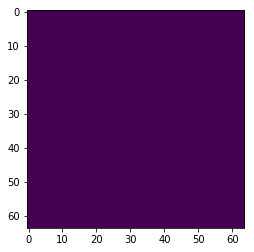
CanICA¶
CanICA is an ICA method for group-level analysis of fMRI data. Compared to other strategies, it brings a well-controlled group model, as well as a thresholding algorithm controlling for specificity and sensitivity with an explicit model of the signal.
[10]:
from nilearn.decomposition import CanICA
canica = CanICA(mask=mask_full, n_components=nb_patterns,
mask_strategy='background',
threshold='auto', n_init=5, verbose=0)
canica.fit(nii_images)
/mnt/datagrid/personal/borovec/Applications/vEnv2/lib/python2.7/site-packages/nilearn/signal.py:139: UserWarning: Detrending of 3D signal has been requested but would lead to zero values. Skipping.
warnings.warn('Detrending of 3D signal has been requested but '
/mnt/datagrid/personal/borovec/Applications/vEnv2/lib/python2.7/site-packages/nilearn/signal.py:51: UserWarning: Standardization of 3D signal has been requested but would lead to zero values. Skipping.
warnings.warn('Standardization of 3D signal has been requested but '
[10]:
CanICA(detrend=True, do_cca=True, high_pass=None, low_pass=None,
mask=<nibabel.nifti1.Nifti1Image object at 0x7f8634425510>,
mask_args=None, mask_strategy='background',
memory=Memory(cachedir=None), memory_level=0, n_components=7, n_init=5,
n_jobs=1, random_state=None, smoothing_fwhm=6, standardize=True,
t_r=None, target_affine=None, target_shape=None, threshold='auto',
verbose=0)
[11]:
components = np.argmax(canica.components_, axis=0) + 1
atlas = components.reshape(atlas_gt.shape)
plt.imshow(atlas)
[11]:
<matplotlib.image.AxesImage at 0x7f862c411ed0>
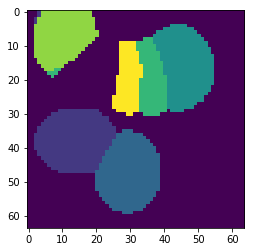
[12]:
max_ptn = np.max(canica.components_, axis=0).reshape(atlas_gt.shape)
atlas[max_ptn < np.mean(max_ptn[max_ptn > 0])] = 0
plt.imshow(atlas)
[12]:
<matplotlib.image.AxesImage at 0x7f862c31c190>
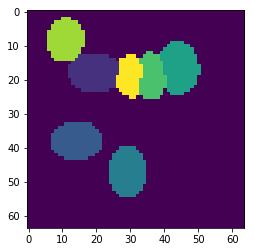
Dictionary Learning¶
Perform a map learning algorithm based on spatial component sparsity, over a CanICA initialization. This yields more stable maps than CanICA.
nilearn.decomposition.DictLearning
[15]:
from nilearn.decomposition import DictLearning
dict_learn = DictLearning(mask=mask_full, n_components=nb_patterns,
mask_strategy='background',
verbose=0, n_epochs=10)
dict_learn.fit(nii_images)
[15]:
DictLearning(alpha=10, batch_size=20, detrend=True, dict_init=None,
high_pass=None, low_pass=None,
mask=<nibabel.nifti1.Nifti1Image object at 0x7f8634425510>,
mask_args=None, mask_strategy='background',
memory=Memory(cachedir=None), memory_level=0, method='cd',
n_components=7, n_epochs=10, n_jobs=1, random_state=None,
reduction_ratio='auto', smoothing_fwhm=4, standardize=True,
t_r=None, target_affine=None, target_shape=None, verbose=0)
[16]:
components = np.argmax(dict_learn.components_, axis=0) + 1
atlas = components.reshape(atlas_gt.shape)
plt.imshow(atlas)
[16]:
<matplotlib.image.AxesImage at 0x7f862c25f3d0>
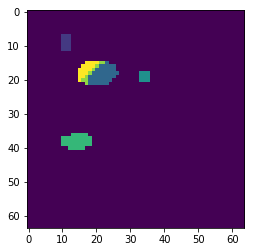
[ ]: